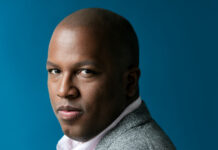
[This story appears in the current March/April 2019 issue of Boston Spirit magazine. Subscribe for free today.]
“You can never be overdressed or overeducated,” Oscar Wilde famously quipped. While many envy Wilde’s flamboyance and wit, fashion—whether stylish or subdued—has long been an important form of self expression for LGBT people. It’s a way to communicate who we are to ourselves, each other and to the world.
Looking at fashion through the prism of gender transgression is a subject as big as the powdery blue Valentino dress Lady Gaga wore to this year’s Golden Globes (with her hair dyed light blue to match). But the Museum of Fine Arts Boston is embracing the task, mounting a major, multimedia exhibition, “Gender Bending Fashion,” that opens March 21 and runs to August 25.
This exhibition looks across a century of haute couture and ready-to-wear fashion that has challenged rigid, binary definitions of dress. Though it looks back, the exhibit is driven by the contemporary moment, says Michelle Finamore, the show’s curator. “One of the things that inspired me to think about this as a subject is what is happening in the world of fashion as it reflects changing mores, these changing ideas of gender especially for millennials and Generation Z where they are thinking about gender as a spectrum rather than something that’s completely binary-driven.”
The exhibit will feature more than 60 boundary-pushing designs, presenting the work of groundbreaking contemporary designers including Rad Hourani, Jean Paul Gaultier, Alessandro Michele for Gucci, Palomo, and Rei Kawakubo in the context of historical trends. These include the garçonne look of the 1920s, a decade that Finamore likens to the modern era in terms of boundary-pushing. “Women started dressing in male style attire; even the body type became a boyish ideal [with] hair bobbed, often so close — a shingle bob. Women were entering the workplace; going out to cocktail parties and bars; they are becoming independent, participating more in sports and appropriating men’s attire.”
The second era that saw a seismic shift in gender bending fashion was the “peacock” revolution of the 1960s and early ‘70s when “unisex” clothing became a thing, blurring the lines between male and female, notes Finamore, and men started to wear more color and patterns, blouses, caftans and jumpsuits. Though women have not stopped wearing pants since trailblazers like Marlene Dietrich and Katharine Hepburn made them fashionable, Finamore admits that skirts and dresses for men have caught on only fleetingly. Despite some social media enthusiasm for the “utlilikilt,” basic attire other than pants for men remains at best a niche.
“Gender Bending Fashion” is a multimedia spectacle that also features video of runway footage, film clips, photography, some paintings and illustrations, a collection of vintage postcards, and record albums since the show pays particular attention to the influence of the music industry and musicians who broke gender barriers with their personal fashion style such as David Bowie and Jimi Hendrix and current icons Lady Gaga and Janelle Monae.
“Janelle Monae was always on my list to include. She came onto the scene with a real gender bending style and maintained it after coming out, which was a key moment for her, professionally,” says Finamore.
Lady Gaga’s LGBT anthem “Born This Way” will be featured on the exhibit’s mix tape that will play throughout the galleries. The show will feature a pair of Lady Gaga’s shoes, designed by Newton native and School of the Museum of Fine Arts graduate Thom Solo who has outfitted style icons from Gaga to Katy Perry with dazzling footwear.
Solo is accessorizing the show’s mannequins, says Finamore, and the Lady Gaga shoes will have a special place in a separate room called “the fashion and gender lab” where visitors can explore ideas raised in the show and share opinions. “Lady Gaga’s shoes are in there because in terms of creative expression and her own perspective, she has been inspirational for people who don’t fit in the box,” says Finamore.
Besides celebrities and haute couture, however, it was important to Finamore and her team to connect couture with the real-life experiences of people. So they put out a call through social media to any Bostonians “who dress with some gender fluidity” to send images to the MFA. “We got great response and great images and these are incorporated into the exhibition,” Finamore says.
It may sound simplistic, but the exhibit underscores the notion that fashion statements are highly individual and deeply personal. “Many people like wearing a uniform. But many want to dress in a way that expresses who they are or how they see themselves,” says Finamore. “Collections come out every day and conversations around gender expression, the language about gender, changes every day, too. I knew [the show] would be the start of a dialogue. It is not the final word, but it will encourage people to address the subject and, hopefully, be enlightening for people.”








